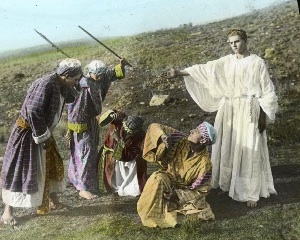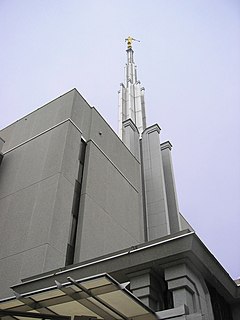Related Research Articles

The Foundation for Ancient Research and Mormon Studies (FARMS) was an informal collaboration of academics devoted to Latter-day Saint historical scholarship. In 1997, the group became a formal part of Brigham Young University (BYU), which is owned and operated by The Church of Jesus Christ of Latter-day Saints. In 2006, the group became a formal part of the Neal A. Maxwell Institute for Religious Scholarship, formerly known as the Institute for the Study and Preservation of Ancient Religious Texts, BYU. FARMS has since been absorbed into the Maxwell Institute's Laura F. Willes Center for Book of Mormon Studies.

Mormon cinema usually refers to films with themes relevant to members of The Church of Jesus Christ of Latter-day Saints. The terminology has also been used to refer to films that do not necessarily reflect Mormon themes but have been made by Mormon filmmakers.
The Mormon blogosphere is a segment of the blogosphere focused on issues related to The Church of Jesus Christ of Latter-day Saints. The term "Bloggernacle" was coined by individuals within the Latter-day Saint blogging community as a play on the name of the Mormon Tabernacle Choir; however, not all Latter-day Saint-themed bloggers like or use the name Bloggernacle, or even consider their blog to be part of it. Furthermore, not all bloggers within the Mormon blogosphere are Latter-day Saints themselves.

Janice Kapp Perry is a composer, songwriter, and author. She is most notable for her work related to her membership in The Church of Jesus Christ of Latter-day Saints. She has written over 3,000 songs, some of which appear in the church's official hymnal, Children's Songbook, and many personal albums, songbooks, and musicals. Some of her most well-known songs include "I Love to See the Temple", "I'm Trying to Be Like Jesus", and "A Child's Prayer". Perry has also composed albums in Spanish, Portuguese, Chinese, Japanese, and Korean.
The God Makers is a book and film highlighting the inner workings and perceived negative aspects of The Church of Jesus Christ of Latter-day Saints. Ed Decker and Dave Hunt co-authored the book and film.
Sexuality has a prominent role within the theology of The Church of Jesus Christ of Latter-day Saints, which teaches that gender is defined in the premortal existence, and that part of the purpose of mortal life is for men and women to be sealed together, forming bonds that allow them to progress eternally together in the afterlife. It also teaches that sexual relations within the framework of opposite-sex marriage is healthy, necessary, and ordained of God. In contrast with some orthodox Christian movements, sexuality in the Church's theology is neither a product of original sin nor a "necessary evil". In accordance with the law of chastity, LDS Church doctrine bars sexual activity outside of heterosexual marriage.

The law of chastity of The Church of Jesus Christ of Latter-day Saints states that "sexual relations are proper only between a man and a woman who are legally and lawfully wedded as husband and wife." In principle, this commandment forbids all same-sex sexual behavior. Homosexuality-related violations of the law of chastity may result in church discipline.
Marlin Keith Jensen has been a general authority of The Church of Jesus Christ of Latter-day Saints since 1989. He served as the official Church Historian and Recorder of the church from 2005 to 2012. He was the 19th man to hold that calling since it was established in 1830. Jensen was made an emeritus general authority in the October 2012 general conference.
Alex Boyé is a British-American singer, dancer, and actor. He was named the "2017 Rising Artist of the Year" in a contest sponsored by Pepsi and Hard Rock Cafe.
Public relations of The Church of Jesus Christ of Latter-day Saints has become increasingly important to the church's hierarchy since the church's growth internationally after World War II. By the 1960s and 1970s, the LDS Church was no longer primarily an Intermountain West-based church, or even a United States-based church. Rather, it had become a worldwide organization.
Mormon studies is the interdisciplinary academic study of the beliefs, practices, history and culture of those known by the term Mormon and denominations belonging to the Latter Day Saint movement whose members do not generally go by the term "Mormon". The Latter Day Saint movement includes not only The Church of Jesus Christ of Latter-day Saints but also the Community of Christ (CoC) and other groups, as well as those falling under the umbrella of Mormon fundamentalism.
LDS Motion Picture Studios is a film studio based in Provo, Utah, and is a directly-managed division of The Church of Jesus Christ of Latter-day Saints.
Stephen Brown Allen is a maker of Latter-day Saint religious and proselytizing films.

The Church of Jesus Christ of Latter-day Saints was established in Japan in 1901 when the church's first missionaries arrived on August 12. Among them was Heber J. Grant, who was then a member of the Quorum of the Twelve and later became the church's 7th president. Horace S. Ensign, Louis A. Kelsch and Alma O. Taylor accompanied Grant. The LDS Church's first baptism in Japan was on March 8, 1902, when Grant baptized Hajime Nakazawa, a former Kannushi. The Book of Mormon was translated three times. The first translation, which took over six years, was completed by Taylor in 1909. It was then recommended that the Book of Mormon be translated into bunshō, a more elegant literary style, which was done by Chōkō Ikuta in 1909, shortly before it was published and distributed. The second translation in 1957 was done by Tatsui Sato. In 1995, the Book of Mormon was translated again into a more colloquial style.
Students identifying as LGBTQIA+ have a long, documented history at Brigham Young University (BYU), and have experienced a range of treatment by other students and school administrators over the decades. BYU is the largest religious university in North America and is the flagship institution of the educational system of The Church of Jesus Christ of Latter-day Saints. Historically, experiences for BYU students identifying as LGBTQIA+ have included being banned from enrolling due to their romantic attractions in the 60s, being required by school administration to undergo electroshock and vomit aversion therapies in the 1970s, having nearly 80% of BYU students refusing to live with an openly homosexual person in a poll in the 1990s, and a ban on coming out into the 2000s. In the contemporary environment there is a continued lack of LGBTQIA+ - specific resources on campus as of 2018, BYU students are at risk of discipline and expulsion by the Honor Code Office for expressions of same-sex romantic feelings that go against the school's code of conduct such as same-sex dating, hugging, and kissing, for gender non-conforming dress, and students and faculty are banned from meeting together in a queer-straight alliance group on campus.
Although the historical record is often scarce, evidence points to LGBT individuals having existed in the Mormon community since its beginnings, and estimates of the number of LGBTQ former and current Mormons range from 4 to 10% of the total membership of the LDS Church. However, it wasn't until the late 1950s that top LDS leaders began regularly discussing queer people in public addresses. Since the 1970s a greater number of LGBT individuals with Mormon connections have received media coverage.
The Church of Jesus Christ of Latter-day Saints has always taught gender roles as an important part of their theology, however, leaders have only recently begun directly addressing gender diversity and the experiences of transgender, non-binary, intersex, and other individuals whose gender identity and expression differ from the norm.
This is a timeline of LGBT Mormon history in the 20th century, part of a series of timelines consisting of events, publications, and speeches about LGBTQ+ individuals, topics around sexual orientation and gender minorities, and the community of members of The Church of Jesus Christ of Latter-day Saints. Although the historical record is often scarce, evidence points to queer individuals having existed in the Mormon community since its beginnings. However, top LDS leaders only started regularly addressing queer topics in public in the late 1950s. Since 1970, the LDS Church has had at least one official publication or speech from a high-ranking leader referencing LGBT topics every year, and a greater number of LGBT Mormon and former Mormon individuals have received media coverage.
This is a timeline of LGBT Mormon history in the 21st century, part of a series of timelines consisting of events, publications, and speeches about LGBTQ+ individuals, topics around sexual orientation and gender minorities, and the community of members of The Church of Jesus Christ of Latter-day Saints.
References
- ↑ Legacy of the Mormon Pavilion - Ensign Oct. 1989. churchofjesuschrist.org. Retrieved on 2010-12-22.
- ↑ Man's Search for Happiness - The Encyclopedia of Mormonism. Eom.byu.edu (2008-03-28). Retrieved on 2010-12-22.
- ↑ New Version of Man's Search for Happiness Produced